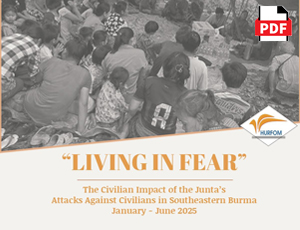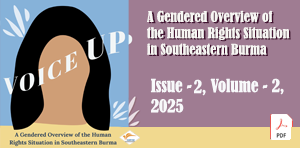Mon people face hard labor in military development projects.
May 4, 2007
Human Rights News Report
More than one hundred Mon civilians in southern Mon State have been forced to work for multiple development projects for three weeks of each month. Most of the civilians have been conscripted to work on bridge constructions. The civilians are forced to do labour on 46 bridges, which includes large and small bridges all along the way along the main road from Ye township to Kaw Zar sub town.
Alongside reports of forced labour there have also been reports of the military increasing the transportation of military equipment to their battalion in Kaw Zar. The development of bridges makes access possible for the transportation of army stuff to their artillery battalion in Kaw Zar sub-town.
The local Burmese a rmy base IB No.31 commander ordered headmen village that for each house one person has to provide forced labor for the construction, reported a local civilian who was also a victim of forced labour. A Mon Human rights worker interviewed a villager from Kaw Zar sub-town who had been forced more than three times in the last month to go to the bridge construction in Ye township. The amount of forced labor is more serious than in January, 2007, said the villager.
rmy base IB No.31 commander ordered headmen village that for each house one person has to provide forced labor for the construction, reported a local civilian who was also a victim of forced labour. A Mon Human rights worker interviewed a villager from Kaw Zar sub-town who had been forced more than three times in the last month to go to the bridge construction in Ye township. The amount of forced labor is more serious than in January, 2007, said the villager.
There are many civilians who would like to refuse to work as they are too poor. Forced labour means that they can’t work in their gardens thus they can’t provide for their families. However, SPDC still calls forced labour Ko Htoo Ko Htta, which means that the civilians are working as volunteers.
SPDC didn?t cooperate with ILO to allow the investigation of ongoing forced labor in southern Mon State. They insisted that security was bad due to a Mon rebel group operating in the area. There was some international media that criticized the SPDC regarding its prohibition of the ILO traveling to these areas.
According to IMNA (Independent Mon News Agency), the forced labor order came from the military officers based in those areas. The news report mentioned that the order came to the headman village and the headman organized the civilians. Some civilians stated that the headman village claimed that the army would pay them 2,500 kyat per day. The civilians had to bring their own food and equipment, however they received no payment.
Many civilians including women and children were forced to labour in the construction of the bridges. Women and children were forced to pile sand and collect stones from the stream. Some constructions sites are far from where the civilians live. ?We don?t want to go to the bridge between Han-Gan and Sin Kuu. It is about 15 miles from our village. But, the leader of Kaw-Zar Township asks us to work for half a day? said a 40-year-old mason from Kaw-Zar Township. Actually, the bridge was not finished even though they worked the whole day. They had to sleep there because it was so far; they then finished it the next day.
SPDC often provides propaganda on Myanmar TV, the state run TV station. The bridge projects are good, they said, to provide transportation for local Mon people. However, NMSP said in their statement on Mon National Day that they were not happy that the SPDC used forced labor.
NMSP had peace talks with SPDC in 1995. Before the peace agreement southern Ye belonged to NMSP. Afterwards the SPDC deployed many battalions to within the cease-fire areas. SPDC didn?t want NMSP to have influence on those areas again if the cease-fire failed.
Comments
Got something to say?
You must be logged in to post a comment.



















































